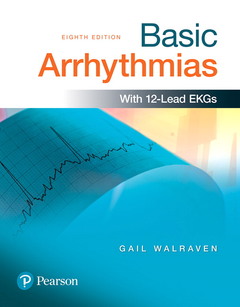Description
Basic Arrhythmias (8th Ed.)
Author: Walraven Gail
Language: English
Approximative price 128.31 €
In Print (Delivery period: 12 days).
Add to cart624 p. · 10x10 cm · Paperback
Description
/li>Contents
/li>Comment
/li>
For all courses in basic or introductory cardiography
Focused coverage and realistic hands-on practice help students master basic arrhythmias
Basic Arrhythmias, Eighth Edition, gives beginning students a strong basic understanding of the common, uncomplicated rhythms that are a foundation for further learning and success in electrocardiography. Concepts are presented in a flexible, progressive approach to allow for self-paced or classroom learning. Chapters cover basic electrophysiology, waves and measurements, rhythm analysis, and the five major groups of arrhythmias. Basic Arrhythmias includes appendices on Clinical Implications, Cardiac Anatomy and Physiology, 12-Lead Electrocardiography, Basic 12-Lead Interpretation, and Pathophysiology of Arrhythmias. Practice EKG rhythm strips are included in most chapters to give students extensive, realistic hands-on practice?the single most important element in developing arrhythmia interpretation skills.
Also available with MyLab BRADY
This title is also available packaged with MyLab? BRADY?an online homework, tutorial, and assessment program that gives you the power to reach students on their terms?and to teach however you like. Encourage students to immerse themselves in the Pearson eText on their own time and use your classroom sessions to workshop key concepts. Or, enhance your lectures with videos and other engaging content that brings course material to life. Fostering engagement both within and outside the classroom, MyLab BRADY helps students better prepare for class, quizzes, and exams?resulting in improved performance in the course.
0134701070 / 9780134701073 Basic Arrhythmias Plus MyLab BRADY with Pearson eText -- Product Package,8/e
Package consists of:
0134380991 / 9780134380995 Basic Arrhythmias
0134381742 / 9780134381749 MyLab BRADY with Pearson eText -- Access Card -- for Basic Arrhythmias
CHAPTER 1
Electrophysiology 1
Self-Instructional Unit Electrical vs. Mechanical Function ¿ Sodium Pump ¿ Polarization, Depolarization ¿ Conduction System ¿ Inherent Rates ¿ Irritability, Escape ¿ Nervous System Influence
¿ KEY POINTS
¿ SELF-TEST
CHAPTER 2
Waves and Measurements 17
Self-Instructional Unit Introduction ¿ Electrodes ¿ Rule of Electrical Flow ¿ Monitoring Leads ¿ Graph Paper ¿ Voltage Measurements ¿ Time Measurements ¿ Cardiac Cycle ¿ Waves, Intervals, Segments ¿ P Wave and PRI ¿ QRS Complex ¿ ST Segment and T Wave ¿ Measurements ¿ Artifact, Interference ¿ Refractory Periods
¿ KEY POINTS
¿ SELF-TEST
¿ PRACTICE STRIPS (PART I)
¿ PRACTICE STRIPS (PART II)
¿ ANSWERS FOR PRACTICE STRIPS (PART I)
¿ ANSWERS FOR PRACTICE STRIPS (PART II)
CHAPTER 3
Analyzing EKG Rhythm Strips
Self-Instructional Unit Analysis Format ¿ Regularity ¿ Rate ¿ P Waves ¿ PR Intervals and QRS Complexes ¿ Role of the AV Node ¿ Ventricular vs. Supraventricular
¿ KEY POINTS
¿ SELF-TEST
¿ PRACTICE STRIPS (PART I)
¿ PRACTICE STRIPS (PART II)
CHAPTER 4
Sinus Rhythms
Self-Instructional Unit
Introduction ¿ Normal Sinus Rhythm ¿ Sinus Bradycardia ¿ Sinus Tachycardia ¿ Sinus Arrhythmia ¿ Review
¿ KEY POINTS
¿ SELF-TEST
¿ PRACTICE STRIPS
¿ INTERPRETATION OF CHAPTER 3 RHYTHM STRIPS
CHAPTER 5
Atrial Rhythms
Self-Instructional Unit Atrial Rhythms 1 ¿ Wandering Pacemaker 1 ¿ Ectopics ¿ Premature Atrial Complex ¿ Atrial Tachycardia ¿ Atrial Flutter ¿ Atrial Fibrillation
¿ KEY POINTS
¿ SELF-TEST
¿ PRACTICE STRIPS
CHAPTER 6
Junctional Rhythms
Self-Instructional Unit Junctional Pacemaker ¿ Junctional P Wave 1 ¿ Premature Junctional Complex ¿ Junctional Escape Rhythm ¿ Junctional Tachycardia ¿ Accelerated Junctional Rhythm ¿ Supraventricular Tachycardia
¿ KEY POINTS
¿ SELF-TEST
¿ PRACTICE STRIPS
CHAPTER 7
Heart Blocks
Self-Instructional Unit Conduction through the AV Node ¿ Heart Blocks ¿ First-Degree Heart Block 2 ¿ Second-Degree Heart Blocks ¿ Type II Second-Degree Heart Block ¿ Wenckebach (Type I Second-Degree Heart Block) ¿ Third-Degree Heart Block (Complete Heart Block)
¿ KEY POINTS
¿ SELF-TEST
¿ PRACTICE STRIPS
CHAPTER 8
Ventricular Rhythms
Self-Instructional Unit
Ventricular Rhythms ¿ Premature Ventricular Complex (PVC) ¿ Unifocal vs. Multifocal ¿ R on T Phenomenon ¿ Runs and Couplets ¿ Grouped Beating 2 ¿ Ventricular Tachycardia (VT) ¿ Ventricular Fibrillation ¿ Idioventricular Rhythm ¿ Asystole
¿ KEY POINTS
¿ SELF-TEST
¿ PRACTICE STRIPS
CHAPTER 9
Practice Makes Perfect
Introduction
¿ PRACTICE STRIPS
CHAPTER 10
Final Challenge
Introduction
¿ SELF-TEST
¿ ANSWERS TO SELF-TEST
APPENDIX A
Cardiac Anatomy and Physiology
APPENDIX B
Pathophysiology and Clinical Implications of Arrhythmias
APPENDIX C
12-Lead Electrocardiography
APPENDIX D
Basic 12-Lead Interpretation
APPENDIX E
Pacemakers
Glossary
Index of Practice Strips by Rhythm Names
Subject Index
Flash Cards
Focused coverage and realistic hands-on practice help students master basic arrhythmias
- Focused coverage helps students master the basic concepts needed to identify arrhythmias. The text covers all the basics of arrhythmia interpretation—including basic electrophysiology, waves and measurements, rhythm analysis, and the five major groups of arrhythmias— and includes appendices on Clinical Implications, Cardiac Anatomy and Physiology, 12-Lead Electrocardiography, Basic 12-Lead Interpretation, and Pathophysiology of Arrhythmias.
- Difficult concepts are presented in a flexible, progressive approach to allow for self-paced or classroom learning. Carefully organized units of consistent length allow for self-paced, independent learning of basic principles, concepts, and techniques.
- Over 680 Practice Strips that provide extensive, realistic hands-on practice. Practice sheets of EKG rhythm strips are included in most chapters to give students hands-on practice. Answers to the end-of-chapter Practice Strips appear on the same pages as the strips themselves for easy access and immediate concept reinforcement.
- UPDATED: This edition includes even more 12-leads for practice.
- UPDATED: Instead of simplified tracings, 12-leads are presented in a more real-world manner.
- Requires no sophisticated equipment so students can learn anywhere, without access to expensive EKG equipment. Students need only a pencil and a set of EKG calipers to start learning.
- UPDATED: Keep your course current with the most up-to-date information. Throughout the Eighth Edition, existing content has been updated for currency and some new content has been added to clarify concepts.
Pedagogical tools help students study more efficiently and use the book as a practical reference
- In-chapter questions help




